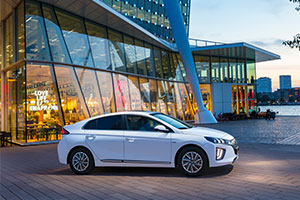smart UK introduces #1 Pro+ to the Motability scheme

smart UK has announced that the award-winning #1 Pro+ is now available to order on the Motability Scheme, opening the door for customers.
Electric vehicles and disability – what are your options?

Many new cars for sale in the not-too-distant future will be electric vehicles, with a complete ban on conventionally-fuelled new cars being mooted as soon as 2030. But what does this mean for people with a disability, asks UCan2 editor Victoria Galligan… You’ve been there – it’s dark, cold and windy outside and you need to stop for fuel. Not only that, but if you need to get your wheelchair out of the car, or have another walking aid to negotiate, if you have trouble using the pump or if there’s a long walk to the shop to pay for fuel then you’re going to be spending more time than is comfortable outside in the horrendous British weather. Wouldn’t it be easier if you could refuel from the comfort of your own home? Or while you were at work? Well nowadays of course you can – thanks to electric vehicle (EV) charging. But is EV charging going to be easy for disabled drivers? You may not fancy buying a brand new electric car right now – but in the next decade or so you probably won’t have a choice. And thankfully some of the negative aspects of running an electric car – such as a lack of EV charging points throughout the country, the need for accessible EV charging bays and the higher forecourt price of electric-powered cars compared to petrol- or diesel-powered models – are, slowly but surely, being addressed. Here, I hope to answer some of the questions you might have about owning an electric vehicle. Are there savings to be made? The forecourt price of electric cars is clearly higher than the price of a conventional car at the moment – but this shouldn’t put you off. As well as the environmental benefits and the convenience of EV charging at home, there are also savings in running costs to be considered, too. We at UCan2 have often highlighted the high price of having a disability – from loss of earnings to the need for adaptations – so saving a cool grand a year on average would be a huge bonus and would certainly make up for the price difference in models when purchasing a new car. £1,000 is how much Pod Point say you could save when running an electric car – including reduced fuel bills, an exemption from road tax and congestion charges, and savings which can be made on general maintenance compared to conventional cars. Do I have to buy an electric car? Certainly not – at the moment. But electric cars are quieter, cleaner and greener and we’re all going to need one soon when the government’s zero-carbon pledge starts drawing nearer. The government announced last year that two-thirds of cars on the road would need to be electric by 2030 to meet the ambitious CO2 reduction target – although the independent advisory panel, Committee for Climate Change, said that this would not be enough and recommended instead that the government should announce a complete sales ban on conventional vehicles starting from between 2030 and 2035. Can I buy an electric vehicle under the Motability scheme? Yes. There are electric cars which you can buy if you receive the Motability benefit – these include: • Smart ForTwo • Smart ForFour • BMW i3 • Hyundai IONIQ • Renault Zoe What about hybrid cars? For those who find it difficult to use an EV charging point regularly or take particularly long journeys, a hybrid can be a great option. There are many hybrid models on offer under Motability, including: • Suzuki Ignis • Suzuki Swift • Hyundai IONIQ • Hyundai Tucson • Kia Niro • Toyota Prius • Toyota Yaris • Toyota Corolla • Toyota Rav 4 • Mini Countryman • Ford Mondeo • BMW 2 Series • Honda CR-V • Mitsubishi Outlander Is charging at home is cheaper? Where to charge an electric vehicle is another dilemma people face when they first buy an electric vehicle. Amazingly, around 200,000 ultra-low electric cars were on the road at the end of Q4 2018. And in July, England became the first country to plan on insisting that all new-build homes have an EV charging point fitted as standard. It costs around £8.40 for a full charge at home (based on a 60kWh battery, with a 200-mile range). A rapid charging point at a service station, in comparison, would cost around £13 for an hour-long, 200-mile charge. Of course, you’ll need an EV charging point installed at home to power up your electric car. You can get help towards the cost of installing one with a government plug-in grant from the Office for Low Emission Vehicles (OLEV): owners of category 1 vehicles, which are classed as “ultra-low emission vehicles” by the government, are eligible for £3,500 in OLEV funding. And the best part? You do not need to do anything if you want to buy one of these vehicles – the dealer will include the value of the grant in the vehicle’s price. If you buy a category 2 or 3 car, you can still get up to £500 towards installing an EV charging point thanks to the Electric Vehicle Homecharge Scheme. Check which models are eligible for which grant at gov.uk. And remember your home electricity now increasingly comes from renewable sources. Fossil fuels are being overtaken by green alternatives when it comes to electricity supply – Carbon Brief reported in October that, for the first time, the UK’s windfarms, solar panels, biomass and hydro plants generated more electricity than the combined output from power stations fired by coal, oil and gas. Where else can I charge up? It’s not just houses which are providing electric vehicles charging points – many fuel stations, workplaces and public facilities are now striving to offer them too. Some workplaces and public sector buildings will offer this for free – some have introduced new electric vehicles charging points with a limited period of free charging – but expect to pay in a